Association of Prescribed Medications with Outcomes from Rehabilitation for Musculoskeletal Pain
引用次数: 0
Abstract
The lead article for this issue of the Journal of Musculoskeletal Pain [JMP] comes from investigators in Trondheim, Norway (1). The authors proposed to evaluate the association between three classes of controlled medications [centrally-acting analgesics (opioids), anxiolytics, and hypnotics] prescribed for patients involved in institutional rehabilitation programs for musculoskeletal pain with the patient’s outcomes from those interventions. Every participant completed the same self-report questionnaire at the beginning and the end of the rehabilitation program. The questionnaires focused on pain, health status, and socioeconomic factors. Linkage of the study subjects to the Norwegian Prescription Database gave the investigators access to the prescribed medications in the three classes of drugs. The term musculoskeletal pain would represent one manifestation of many specific medical conditions that could benefit from a rehabilitation program. In many cases, pharmacological therapy specific to the relevant diagnosis would have been initiated before the patient was referred for a rehabilitation program. In addition, the individual rehabilitation programs may have differed based on the given diagnosis and its severity, but recall that the focus of this study was upon prescriptions for three specific classes of controlled medications and their relationships to the outcomes resulting from the rehabilitation program. The investigators evaluated 1564 individuals in rehabilitation programs for musculoskeletal pain and found that 36.4% of the patients [N1⁄4 569] were given a prescription for a controlled medication in one of the three monitored classes. If a drug was prescribed, the authors assumed that it was used as directed. Interestingly, they found that the administration of centrally acting analgesics did not predict a good outcome among patients with musculoskeletal pain. Indeed, the prescriptions of hypnotics, and particularly of anxiolytics, were associated with the better outcomes. That being the case, it was surprising that there was no mention of sleep, sleep dysfunction, or insomnia among the authors’ measured outcomes. The authors found no relationship between the use of one of the classes of controlled medications and an existing diagnosis of an affective disorder like depression or anxiety. The second original contribution in this issue, relating to systematic assessment of delayed onset muscle soreness, comes from Joondalup and Brisbane, Australia (2). This study was designed to characterize post-exercise muscle pain when the exercise was intentionally eccentric. Questions answered by this study include the time course of visual analog scale subjective pain resulting eccentric exercise. Does this kind of muscle trauma cause allodynia? If so, does the time course of the resultant allodynia differs from that of the pain? To what extent does the subjective pain correlate with the allodynia? Do muscle pain or tenderness in this condition vary with the examined location in the length of the affected muscle? Finally, which of these measures do the investigators believe most accurately documents post-exercise muscle pain? The reader will be intrigued by the availability of answers to such precise questions. Since the eccentric exercise was experimentally induced unilaterally and consistently involved the no-dominant arm, it would have been interesting to know whether the paired contralateral muscle became symptomatic or developed allodynia to suggest a centrally mediated process. If there was referral to the contralateral unexercised muscle, did the referral more resemble myofascial pain syndrome or complex regional pain syndrome? A controlled clinical crossover study of the role of experimentally-induced peripheral pain [a form of attentional distraction] on head positioning was处方药物与肌肉骨骼疼痛康复结果的关系
本期《肌肉骨骼疼痛杂志》(JMP)的主要文章来自挪威特隆赫姆(Trondheim)的研究人员(1)。作者建议评估为肌肉骨骼疼痛的机构康复计划患者开的三类受控药物[中枢镇痛药(阿片类药物)、抗焦虑药和催眠药]与患者干预后的结果之间的关系。每个参与者在康复计划开始和结束时都完成了相同的自我报告问卷。问卷主要关注疼痛、健康状况和社会经济因素。研究对象与挪威处方数据库的联系使研究人员能够获得三类药物中的处方药。肌肉骨骼疼痛这一术语代表了许多可以从康复计划中受益的特定医疗状况的一种表现。在许多情况下,针对相关诊断的药物治疗在患者被转介到康复计划之前就已经开始了。此外,个体康复计划可能会根据给定的诊断及其严重程度而有所不同,但请记住,本研究的重点是三种特定类别的受控药物的处方以及它们与康复计划结果的关系。研究者对参加肌肉骨骼疼痛康复项目的1564名患者进行了评估,发现36.4%的患者[N1⁄4 569]在三个监测班级中的一个班级中得到了控制药物的处方。如果一种药是开的,作者就认为它是按照指示使用的。有趣的是,他们发现在肌肉骨骼疼痛患者中使用中枢镇痛药并不能预测良好的结果。事实上,催眠药的处方,尤其是抗焦虑药,与更好的结果有关。在这种情况下,令人惊讶的是,在作者的测量结果中,没有提到睡眠、睡眠功能障碍或失眠。作者发现,使用一类受控药物与现有的抑郁或焦虑等情感障碍诊断之间没有关系。本期的第二个原创贡献来自澳大利亚Joondalup和布里斯班(2),涉及延迟性肌肉酸痛的系统评估。该研究旨在描述运动后肌肉疼痛的特征,当运动是故意偏心的。本研究回答的问题包括视觉模拟量表主观疼痛引起偏心运动的时间过程。这种肌肉损伤会引起异常性疼痛吗?如果是这样,由此产生的异常性疼痛的时间过程与疼痛的时间过程不同吗?主观疼痛在多大程度上与异常性疼痛相关?在这种情况下,肌肉疼痛或压痛是否随受影响肌肉长度的检查位置而变化?最后,研究人员认为哪一种测量方法最准确地记录了运动后的肌肉疼痛?读者会对这些精确问题的答案感兴趣。由于偏心运动是单侧实验诱导的,并且始终涉及非优势臂,因此了解成对的对侧肌肉是否出现症状或发展为异常性疼痛以提示中枢介导的过程是很有趣的。如果有转介到对侧未运动肌肉,转介更像肌筋膜疼痛综合征还是复杂区域疼痛综合征?实验诱导的外周疼痛[一种注意力分散的形式]对头部定位的作用进行了对照临床交叉研究
本文章由计算机程序翻译,如有差异,请以英文原文为准。
求助全文
约1分钟内获得全文
求助全文

 求助内容:
求助内容: 应助结果提醒方式:
应助结果提醒方式:


